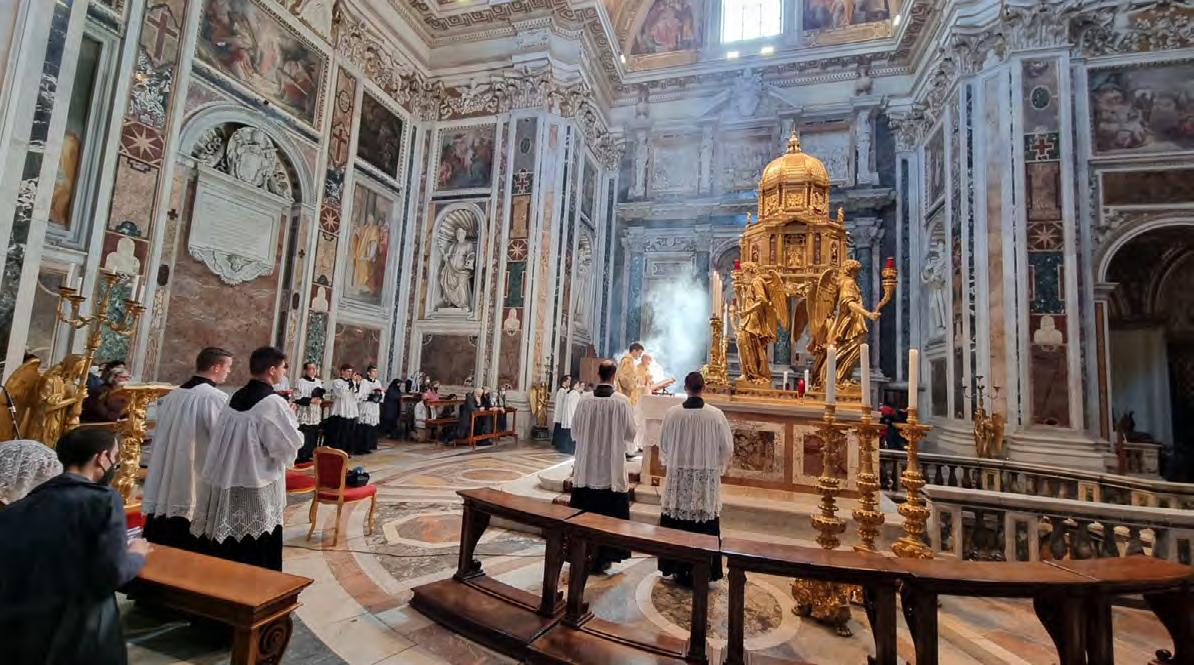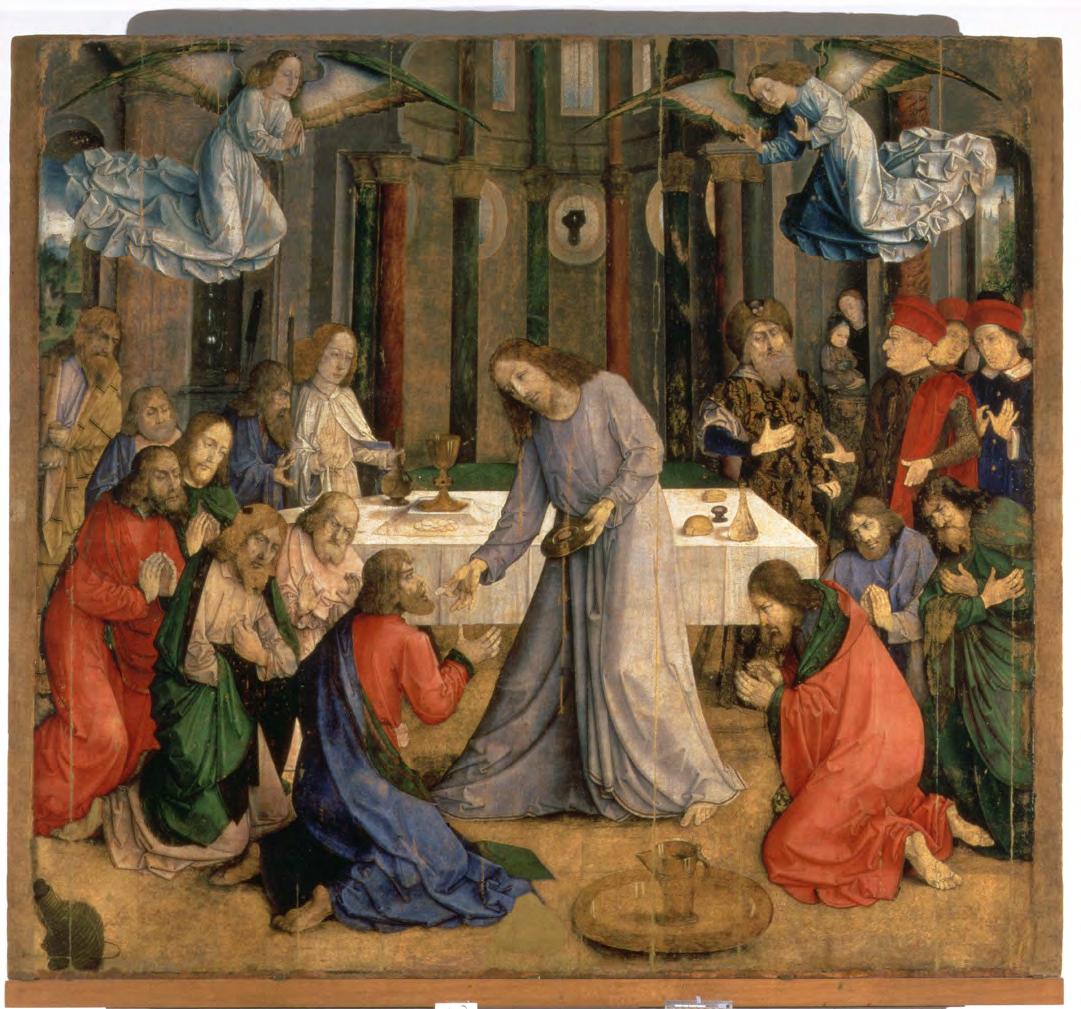
12 minute read
Liturgical anarchy
Joseph Shaw on the crisis of the 1960s
The following is an extract from a forthcoming book on the Petitions to save the Traditional Mass which started to appear in 1966.
The Petitions of intellectuals and artists seeking the preservation of the Traditional Latin Mass, which were published in 1966 and 1971, emerged from a period of escalating liturgical and doctrinal crisis in the Catholic Church. As far as the liturgy was concerned, Fr Bryan Houghton, then parish priest of Bury St Edmunds, and dean in the rural depths of East Anglia, noted in his autobiography, Unwanted Priest: ‘I forget the dates, but certainly vernacular liturgies were said in my deanery long before official permission was given in 1964. I managed to stop it for parochial Masses but not for private Masses. Experiment was in the air. It was reported to me that one priest was saying mass on weekdays in the presbytery dining-room, during breakfast, with consecrated toast.’ 1
Even official organs of the Church were horrified at what was going on. In his book Torn Tunic, Tito Casini quotes an article in L’Osservatore Romano from May 1965 describing sacred vessels being reused for profane purposes: ‘And still worse, the precious reliquaries now stand as ornaments between flower-vases and liqueur bottles… monstrances used to encase clocks and barometers. Even chalices are not spared from providing pedestals for lamps and profane statues in boudoirs on whose tables ash-trays made from patens show the sign of the cross when not covered with the ash of cigars…’ 2
In many places, very serious liturgical abuses were being imposed on the Faithful during the celebration of Sunday Mass. Pope Benedict recalled this era in his Letter to Bishops accompanying Summorum Pontificum: ‘Many people who clearly accepted the binding character of the Second Vatican Council, and were faithful to the Pope and the Bishops, nonetheless also desired to recover the form of the sacred liturgy that was dear to them. This occurred above all because in many places celebrations were not faithful to the prescriptions of the new Missal, but the latter actually was understood as authorizing or even requiring creativity, which frequently led to deformations of the liturgy which were hard to bear.
I am speaking from experience, since I too lived through that period with all its hopes and its confusion. And I have seen how arbitrary deformations of the liturgy caused deep pain to individuals totally rooted in the faith of the Church.’
The Reform and the Clergy
Fr Houghton recalls the sudden transition from Latin to the vernacular in 1964: ‘A pure permission was given, and they all jumped to it like the Gadarene swine. Besides, I had been dean for a number of years and knew the priests of my deanery very well. Only two of them were sufficiently stupid to think themselves brilliant—and consequently welcomed the opportunity to express their personality. The rest, in private, were against the changes. However, only one, a Dominican, stuck to the old Mass.’
As Fr Houghton exclaims, this is a phenomenon which calls for explanation. An important part of it was a crippling inferiority complex felt by many of the more conservative clergy. In a letter to Evelyn Waugh in 1964, Cardinal Heenan explains: ‘The hierarchy is in a difficult position. We have not yet lost the respect of ordinary Catholics but the constant nagging of the intellectuals and their tireless (tiresome?) letters to the Press and articles in the Catholic papers may eventually disturb the ordinary faithful. Most of us would be content to delay changes but the mood of the Council compels us to act. Otherwise the attack from our own people would become ever more bitter: inimici hominis domestici scies [“a man’s enemies shall be of his own household”: Mat 10:36]’ 3
Heenan’s words make sense of Fr Houghton’s extraordinary last meeting with Bishop Parker of Northampton (East Anglia at that time was still part of that diocese), 4 who was about to retire, in December 1966. Fr Houghton found himself alone with him: ‘I took him by the lapels of his jacket and shook him: “Good heavens, my Lord! I have known you for twenty-five years. You don’t agree with what is going on! Why don’t you have the courage of your convictions?” He looked away and said nothing.’
The pressures of superiors or the peergroup, the fear of ridicule or denunciation by those agitating for the reform, a sense of inevitability: such considerations can still only explain the way the reform was actually accelerated and exaggerated by those implementing it, if we add the wider context of a clergy who had for some reason ceased, as Fr Houghton expresses it, to love the Mass.
Fr Houghton explains this, in turn, by reference to the gradual replacement of a spirituality of contemplation with a spirituality of activism, initiated, in his view, by the Jansenist movement. Whatever it was, this process had not had the same effect on the laity as it had on the clergy by 1964: many of the laity still did love the Mass. And now, the Mass they had grown to love, of which Latin was a defining feature, had suddenly vanished from the scene.
Until 1970 Cardinal Heenan insisted that one Mass be celebrated in Latin each Sunday in the Archdiocese of Westminster, but this was exceptional, despite vague supportive statements about the celebration of Mass from, for example, the Bishops’ Conference of England and Wales in 1968. Some priests enthusiastically, some with reluctance, adopted the vernacular, and so it has been ever since: the reformed Mass in Latin is a rarity, found here and there, more often than not the subject of official disapproval.
Liturgical abuses and Doctrine
The enthusiasts among the clergy, joined by some lay intellectuals, were not content with what the reforming Instructions were officially permitting, and as noted a period of liturgical chaos ensued. This also requires some explanation. How is it that the famously disciplined Church of the 1950s developed into the chaotic Church of the 1960s?
This phenomenon of course needs to be qualified. The abuses of the 1960s were to be found above all in the rich West, rather than Africa, Latin America, Asia, or the Communist bloc. Other parts of the world were certainly affected by the liturgical reforms, but the effects on liturgical discipline were slower to manifest themselves. Even within Western Europe and North America, the more outrageous elements were to be found above all in particular places: university chaplaincies, seminaries, religious communities, and, in general, cities. It was only by an effort, over the course of years, that even a less extreme interpretation of the Church’s new orientation could be imposed by bishops on country parishes guarded by determined priests of the older generation.
The most extreme expressions of liturgical anarchy took place in the context of a revolt against the teaching of the Church, notably on contraception, a teaching reiterated by Pope Paul VI in his encyclical Humanae Vitae in 1968. This revolt itself found its place in a wider revolt against authority, of which the year 1968 is the enduring symbol, with its riots against the Vietnam War in the USA, and the student riots of Paris. With hindsight, it is difficult to imagine a less auspicious peace-time decade for the Church to have undertaken a sweeping reform of the liturgy.
The explosion of the 1960s in terms of secular culture and politics had its parallel in the Church because many of the causes of the secular crisis also had their effects on the Church. In his book Mass Exodus, the sociologist Stephen Bullivant has demonstrated for the Catholic Church in Britain and America, what Robert Putnam, in Bowling Alone, focusing on the United States, showed for society as a whole: a series of factors served to weaken the sense of community, and community norms, leading up to the 1960s. Notable among these were the migrations caused by the Second World War, and the experiences of those directly involved in it; war-damage to housing, followed by slumclearance, and suburbanisation; higher rates of tertiary education; and the spread, first of the radio, and then of television. It is hardly surprising to hear that community values and expectations of behaviour are most powerfully influential the more an individual is immersed in the community. Insofar as community members are exposed to radically different values and expectations, their allegiance to their own will be weakened.
This happened in the Church, as it happened to the whole of society, to some individuals and groups to a much greater extent than to others. The rebellion in its more dramatic aspects was the action of an influential minority, a minority, indeed, incapable of delivering electoral success: both the USA and France held Presidential elections in 1969 which were won by cultural conservatives, Richard Nixon and Georges Pompidou. It remains the case, however, that even the more sheltered communities were weakened, and as far as the Catholic community goes, we would expect to see higher rates of lapsation, increased marrying outside the community, and so on, even if the liturgy had stayed the same.
In this context, the reform of the liturgy, at first tentative, and then allencompassing, had two effects. First, it appeared to vindicate the forces of rebellion, as it suggested that there had been something radically amiss in the liturgy up to that point. Secondly, it served to undermine still more the already weakening sense of community within the Church.
The second point is the thesis of Stephen Bullivant: the Catholic Church weathered the social, cultural and economic storm of the 1960s and 1970s less well than comparable religious groups because her distinctive ancient liturgy had been a key plank of Catholic identity, and at a crucial moment, when other planks were under stress or giving way, this one was abruptly removed. The concern of the present discussion is, however, more on the first point: the vindication of the idea that the old Catholic liturgy had been seriously defective.
Christopher Sykes, whose name appears in the Italian-led additional list of signatories for the 1971 petition, was exasperated at the way priests who had defended the Latin Mass for years suddenly reversed their positions. He wrote in The Tablet in 1966: “Were they consciously talking nonsense all those years, or are they really sincere in their criticisms (which sometimes amount to denigrations) today? Either way, the clergy who indulge in this propaganda are weakening their authority in the minds of people who can remember.”
Fr Houghton had the same thought in 1971, writing to Cardinal Heenan about the crisis of priestly identity: “It is beside the point whether or not the violent changes which have taken place over the past ten years have been objectively good or bad. What is important is that they have been of such a nature and introduced in such a way as to undermine the credibility of the clergy.”
This was problematic in itself, but the crisis of credibility was very useful to those radically opposed to the teaching of the Church. If, they implied, the Church had been fundamentally wrong about the liturgy and spirituality for over a millennium, then she could be wrong about doctrine as well. The “denigration” of the old Mass Sykes notes became a weapon in the hands of dissenters. This is described by Anne Roche Muggeridge (daughter-in-law of Malcolm Muggeridge), in her book The Desolate City, in terms of “the rituals of the revolution”, drawing a parallel with political revolutions such as the American Revolution: “These rituals are designed to diminish the power of existing authority by destroying its mystique during a process in which the symbols that inspire awe are mocked and degraded in ‘reversed ceremonies of legitimacy’. The mocking reversal of sacred symbols serves as a psychological preparation for a transference of allegiance.”
She goes on: “…the main target was the Mass… Nothing could change as long as this great symbol-complex could not. Therefore, parodies of the old Mass became frequent among liturgists, most of them priests, during the introduction of the early liturgical changes. In one local instance, a late-middle-aged hitherto notably pious bent exaggeratedly over the Mass book on the altar gabbling nonsense ‘Latin’ as a prelude to his sermon on how much more sensible the new way was than ‘the way we used to do it’.”
Liturgical abuses commonly attack the doctrines of the Real Presence and of the Priesthood, particularly the all-male Priesthood, but the wider significance of abuses as an act of rebellion should be underlined. If the old Mass was wrong, if the Church had been giving her children stones for bread all those centuries, this was not just a reason for making some liturgical adjustments: it cast doubt on the Church’s spiritual credibility. The point was explicitly brought to bear on the question of contraception in 1968. Muggeridge describes a parody-liturgy conducted by 300 priests who had been suspended by their bishops, as a protest at the US Bishops’ Conference meeting which was to formulate a response to Humanae Vitae, in November 1968.
Sir Arnold Lunn alluded to this aspect of the liturgical issue in his address to the Annual General Meeting of the Latin Mass Society in 1966. Noting the various motives for defending the Latin Mass, he added: “There is also clear evidence that in certain circles there is a definite animus against the Latin Mass, which is for some ultra avant-garde Catholics a symbol of much that they hope radically to change. So in defending the Latin Mass we are perhaps defending more than we know.”
1. Unwanted Priest p67 2. Quoted in Casini The Torn Tunic p10 3. Reid A Bitter Trial pp44-5 4. It became a separate diocese in 1976.










